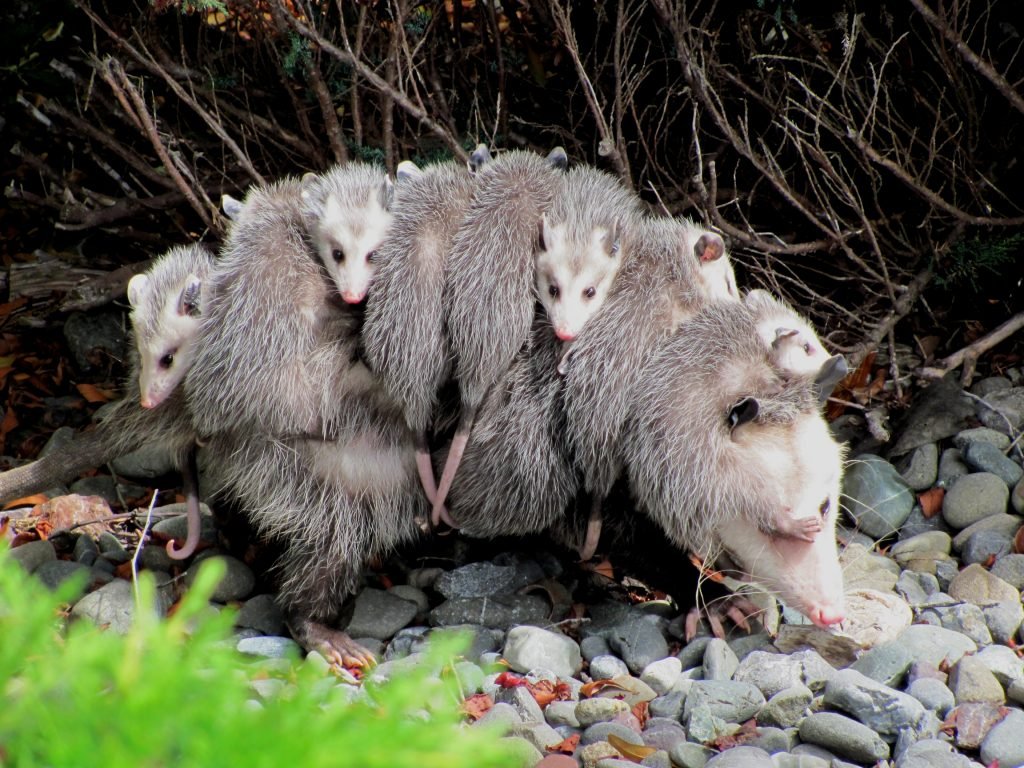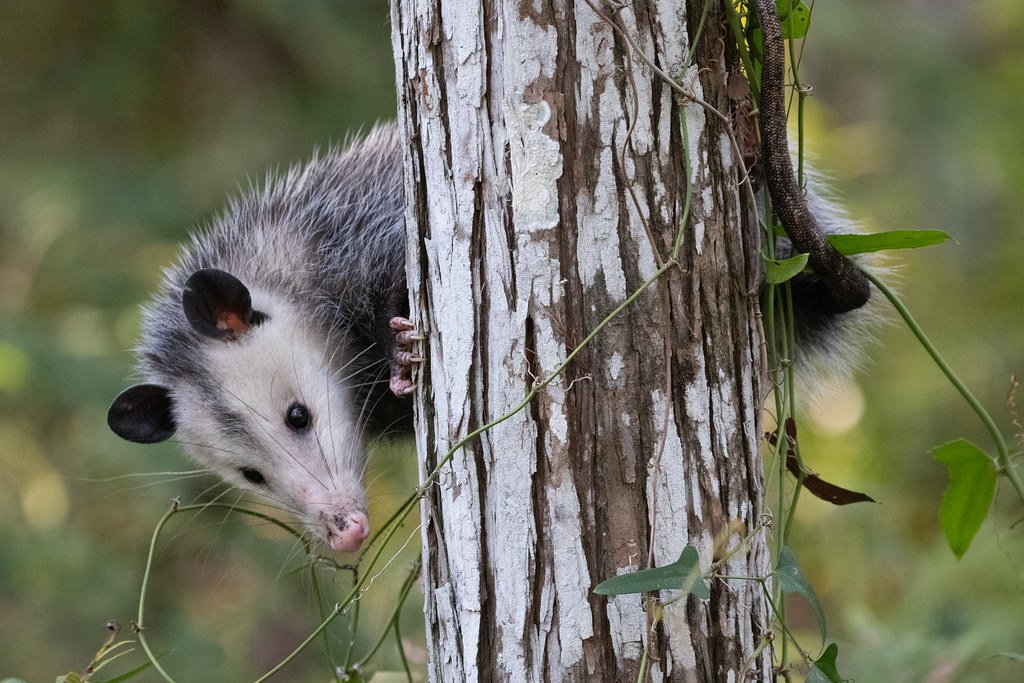Opossums: Didelphis Virginiana

If you have opossums in your yard or house, something there likely attracted them. Opossums are omnivores who eat a wide variety of foods. Pick up any ripe fruit and vegetables from your garden, place garbage in cans with tight-fitting lids, and pick up any unattended pet food. Feeders for birds and squirrels should not be easily accessible.
Learn More: Pests In The Attics
Opossum Description & Size
A house cat-sized opossum has coarse grayish fur, a pointed face, and hairless, rounded ears. The opossum can carry things like nesting materials and even hang upside down from a tree branch thanks to its long hairless prehensile tail.
Opossums on average are 2 to 3 feet long, including the tail, and can weigh up to 15 pounds, though most of them weigh between 4 and 7 pounds. Males tend to be bigger than females. Their feet have five widely spread fingers, like small hands. Except for the opposable thumb on the back foot, all toes have claws. Climbing is second nature to opossums—the opposable toe on the back foot aids in grasping small branches or other structures. 1Go To Source ipm.ucanr.edu -“Opossum”
Behavior Of Opossums
Opossums spend the majority of their short lives alone. Adults who briefly associate while mating, female-young family groups, and groups of up to 8 individuals sharing a winter den are examples of exceptions. As an adult, the opossum is a few mammals that do not have a fixed or permanent home range. Adults are sedentary in some cases, but many wander, often following watercourses and establishing temporary dens in new areas.
The radius and size of a home range are determined by the availability of food, water, and dens, as well as an individual’s mobility. Home sizes range from 1 to 40 hectares. Opossums can reach densities of 2-3 per hectare in the Midwest’s most suitable habitats.
Opossum Social Interactions

The opossum’s social interactions are governed by chemical, vocal, visual, and tactile signals. The first three channels of communication are the most developed of the four. The opossum hisses, growls, screeches, and makes “clicking sounds” in aggressive situations, the latter also accompanying male courtship posturing.
Adults use their teeth to threaten each other and predators, arching their backs with their fur erect and secreting a foul-smelling greenish fluid from their paired anal glands. Males have skin glands on their chests that give their fur a yellowish color and may play a role in chemical communication.
This mammal is known for “playing possum” or feigning death by falling over on its side and remaining motionless for periods ranging from a few minutes to six hours. This behavior tends to deter or shorten a predator’s attack. 2Go To Source esf.edu -“Opossum (Didelphis virginiana Kerr)”
Reproduction Habits Of Opossums
Virginia opossums are ready to breed in their first year, around 6 months for females and 8 months for males, but they don’t usually start breeding until they’re 10 months old. This species has a long breeding season, but the exact months vary depending on where the individual is located.
The months opossums reproduce are from February to September in populations found at 44° N latitude, whereas it lasts from January to August in populations found at 30°N latitude. Similarly, the number of litters produced each year varies depending on the climate. Virginia opossums have only one litter per year in northern regions; however, in warmer climates, the number of litter may increase to three per year.
4 to 25 “honey bee-sized” young are born after a concise gestation period of 12 to 13 days, despite females having only 13 mammae, some of which may be nonfunctional. The offspring are typically 14 mm long and weigh between 0.13 and 0.20 grams. Despite their lack of development, newborns have muscular front legs that allow them to climb to their mother’s pouch. Many young will perish during the pouch journey; those that do will remain attached to the mammae for 50 to 70 days; females have an average of 8 pouch-young per litter.
Young remain with their mother after spending time in the pouch, either riding on her back or staying in the den while she forages. Young begin eating solid food around the age of 85 days and are fully weaned between the ages of 93 and 105 days. Young are typically independent after this period, though some will remain in the weaning den with their mother until they are around 120 days old. Approximately 60% of the young will perish once they are fully self-sufficient.3Go To Source biokids.umich.edu -“Virginia opossum Didelphis virginiana”
Opossum Preferred Habitat

Opossums prefer forested or brushy environments, but they’ve adapted well to life in cities and suburbs.
Opossums will build their dens almost anywhere that is dry, sheltered, and secure. Burrows dug by other mammals, hollow stumps, rock crevices, woodpiles, and spaces beneath buildings are all examples. Dried leaves, grass, and other insulating materials are used to fill their dens. To avoid predators, opossums move between several active dens.
Range & Distribution Of Opossums
Virginia opossums can be found east of the Rocky Mountains in the United States and along the west coast from British Columbia, Canada, to Baja California. Mexico and Central America are also home to this species. The animal can be found in various environments, such as open woods, deciduous forests, and farmland. Swamps, marshes, and streams are among its favorite habitats.
Opossum Diet
The Virginia opossum is nocturnal and hunts for food with its keen sense of smell. It is omnivorous, meaning it eats a wide variety of plants and animals, including fruits, insects, and other small animals. It eats garbage and carrion on occasion. Carrion is defined as dead animals. Opossums are frequently killed by cars while searching for food on highways because so much carrion is roadkill.
Opossums As Pests

Opossums make their homes in attics and garages, where they can create a cluttered nest. If they gain access to the interior of a home, they can rip ductwork or insulation. They can damage lawns when digging for food. Opossums are capable of destroying poultry, game birds, and their nests. Opossums can hiss and bare their sharp teeth when startled. If they feel threatened, opossums may bite in rare cases.
Although opossums’ lifestyle makes them seem like ideal rabies hosts, they rarely contract the disease and are even less likely to transmit it. On the other hand, opossums can carry a variety of diseases, including leptospirosis, tularemia, and tuberculosis, to name a few. They can also become infested with fleas and mites, especially if they live in a city.
Damage Caused By Opossums
Opossums can tear up air ducts in the attic, especially if the animal is trapped. Most opossums will tear and break air ducts and anything else in their path with their sharp teeth and claws. When an air duct is torn, it needs to be replaced right away. Because opossums are excellent climbers and grow large quickly, they should not be kept in attics for long periods of time.
Opossums have been known to damage insulators and electric wires in the attic, in addition to air ducts. When insulators or wire cables are cut, there is a greater risk of fires, resulting in the entire building being burned down.
Opossums are known for excreting a large amount of waste, which can be unsightly inside the attic. The animals have the ability to use the attic as a toilet, and the turds they leave behind can be quite large. Opossum waste is notorious for stinking up the place and can even spread diseases to people living in the home.
Opossum Trapping, Removal & Prevention
Entrances to attics and garages, as well as the areas around garage doors and windows, attic vents, and gaps in walls or siding, should be sealed up to reduce the likelihood of opossums making their homes in residential yards. Opossums are deterred from reaching roofs and attics by trimming overhanging tree branches and overgrown shrubbery.
Opossums are still wild animals, even if they are not aggressive. As a result, any removal attempts should be carried out by a trained professional. Opossum behavior is well-understood by Animals Happen experts, who can effectively eradicate infestations. Professionals have the knowledge, resources, and certifications to safely and properly handle marsupials, whereas untrained individuals do not.
Sources:
- Baldwin, Roger. “Opossum Management Guidelines–UC IPM.” University Of California Agriculture & Natural Resources, Regents of the University of California, Oct. 2015, ipm.ucanr.edu/PMG/PESTNOTES/pn74123.html.
- Communications, Esf Office Of. “Opossum | Adirondack Ecological Center | SUNY ESF | College of Environmental Science and Forestry.” SUNY College Of Environmental Science And Forestry, State University of New York, www.esf.edu/aec/adks/mammals/opossum.htm. Accessed 11 Mar. 2021.
- Siciliano Martina, L. 2013. “Didelphis virginiana” (On-line), Animal Diversity Web. Accessed March 10, 2021 at http://www.biokids.umich.edu/accounts/Didelphis_virginiana/
